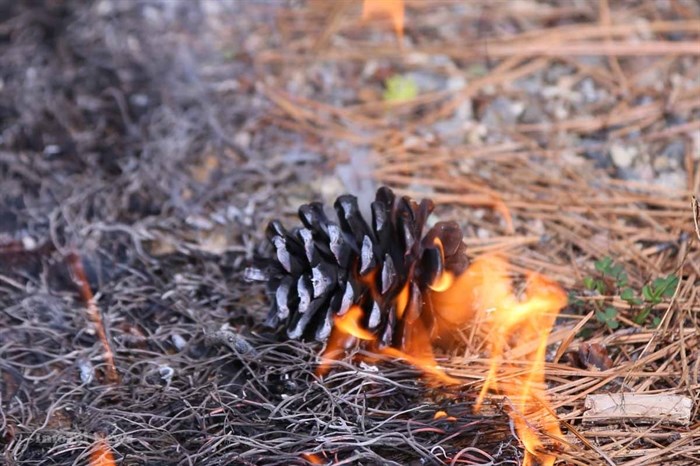
FILE PHOTO
(JENNIFER STAHN / iNFOnews.ca)
September 03, 2023 - 7:00 AM
As well as a devastating loss of homes, properties and infrastructure, the McDougall Creek wildfire has caused loss of habitat for countless species, in turn raising the question: what will happen to the animals whose homes have also been destroyed?
While their homes and habitat are going up in flames, animals are flocking to nearby neighbourhoods for safety.
The BC Conservation Officer Service released a statement this week warning the public about the potential dangers of these temporarily displaced animals.
Currently, homes that have been left empty or without power may have rotting food that can attract bears and other wildlife, creating a risk to public safety.
Attractants, such as, garbage, fruit trees, bird seed and pet food will draw wildlife towards residential areas and homes, warns the conservation officer service. There may also be temptation for people to feed the displaced animals, which the officers ask people not to do.
Feeding wildlife causes habituation and food conditioning that in turn jeopardizes public safety and animal welfare, the conservation service said.
However, the public concern for wild animal welfare does not come without reason. The McDougall Creek wildfire is estimated to have burned over 12,600 hectares of forested land, making the loss of natural habitat incomprehensible and disturbing.
Yet, Steve Hamilton from BC Wildlife Federation told INFOnews.ca that, despite the destruction, the wildfires could actually benefit habitats in the long run.
“In nutshell, fires are absolutely devastating for infrastructure and how they affect people,” Hamilton told INFOnews.ca. “But in the grand scheme of things it’s an incredible thing for wildlife and habitat. There’s a lot of rebirth, there’s a lot of sight lines that are cleared out, there’s a lot of understory that is taken away and, in the long run, it’s a good thing.”
Hamilton said the Okanagan is home to a dense population of pine trees, which tend to grow close together. When pine trees shed their acidic needles, they leave a “duff layer” that dries out and prevents any new growth on the forest floor. When a hot fire travels through the area, it clears up the debris, making way for the growth of new plant and vegetation for animals.
“Some trees, for example pine trees, their columns are opened up by [the fire’s] heat, so they actually seed themselves,” he said, “you get away from a mono-crop and you end up with more diverse trees and grasses on the landscape for wildlife.”
Hamilton said planting only one species of trees in a particular area, also known as a monoculture, increases the threat of out-of-control wildfires.
“When you plant one species of tree, it’s not diverse,” he said. “The best thing you can do for wildlife and habitat is have a mixed forest. You want your deciduous, you want coniferous, you want your grasses, you want a natural cycle on the landscape.”
Another problem arises when we do not allow fires to naturally rebalance the ecosystem, Hamilton said. Wildfires occur naturally in the Okanagan and some plant species have evolved to rely on them for growth and rebalance.
“Unfortunately, over the last 30 to 50 years we’ve become too good at fighting forest fires,” he said. “When you get a build-up of fuel layers like we’re seeing now, unfortunately, fires run away and we’re seeing hundreds if not thousands of people displaced.”
“Prescribed burns and cultural burns in conjunction with First Nations are absolutely needed on the landscape in the off season. A little bit of smoke then, prevents what we’re going through now.”
However, Mathieu Bourbonnais, Ph.D. Assistant Professor in Earth, Environmental and Geographic Sciences at UBC Okanagan said it’s not that simple. While fires can be beneficial to some species, Bourbonnais said it can be detrimental for others.
“It’s not like a one size fits all with wildlife,” Bourbonnais told INFOnews.ca.
Bourbonnais explained that while low intensity wildfires can stimulate growth of forage, berries and grasses which bears and ungulate species like deer and moose eat, they can also cause detrimental habitat loss to more sensitive animals such as caribou and lynx.
“High severity fire can destroy [caribou] habitat. We're talking old growth trees that support lichen, that support food sources, and they're really sensitive animals to begin with,” he said. “The Canada lynx relies on a certain age of forest to create habitat for hunting opportunities.”
Although smaller fires may replenish the landscape and ecosystems, the severe fires sweeping the province now may be harmful to many species, Bourbonnais explained.
“There’s certain species that are a little bit more sensitive to fire and if we're getting bigger, higher severity fires, they might be impacted the most,” he said. “But for animals in general, high severity fire is not oftentimes what you want.”
To contact a reporter for this story, email Georgina Whitehouse or call 250-864-7494 or email the editor. You can also submit photos, videos or news tips to the newsroom and be entered to win a monthly prize draw.
We welcome your comments and opinions on our stories but play nice. We won't censor or delete comments unless they contain off-topic statements or links, unnecessary vulgarity, false facts, spam or obviously fake profiles. If you have any concerns about what you see in comments, email the editor in the link above. SUBSCRIBE to our awesome newsletter here.
News from © iNFOnews, 2023